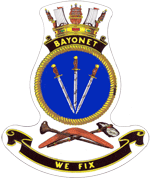HMAS Bayonet (P 101) facts for kids
Quick facts for kids History |
|
|---|---|
| Builder | Evans Deakin and Company |
| Laid down | October 1968 |
| Launched | 6 November 1968 |
| Commissioned | 22 February 1969 |
| Decommissioned | 26 June 1988 |
| Reclassified | Reserve (27 March 1982) |
| Motto | "We Fix" |
| Fate | Scuttled |
| Badge |  |
| General characteristics | |
| Class and type | Attack class patrol boat |
| Displacement |
|
| Length | 107.6 ft (32.8 m) length overall |
| Beam | 20 ft (6.1 m) |
| Draught |
|
| Propulsion |
|
| Speed | 24 knots (44 km/h; 28 mph) |
| Range | 1,200 nautical miles (2,200 km; 1,400 mi) at 13 knots (24 km/h; 15 mph) |
| Complement | 3 officers, 16 sailors |
| Armament |
|
HMAS Bayonet (P 101) was a special kind of ship called an Attack class patrol boat. It was part of the Royal Australian Navy (RAN). Patrol boats are smaller ships used to guard coastlines and waters.
Building the Attack Class Patrol Boats
The Attack class boats were ordered in 1964. The navy needed new ships to patrol Australia's waters. They also wanted to replace older boats used for patrols, rescue missions, and other jobs.
At first, nine boats were ordered for the Australian Navy. Five more were built for Papua New Guinea's coastal security. Later, six more ships were ordered, making a total of twenty Attack class vessels.
These patrol boats were not very big. They weighed about 100 tons when empty and 146 tons when fully loaded. Each boat was about 107.6 feet (32.8 meters) long. They were 20 feet (6.1 meters) wide. The bottom of the boat sat about 6.4 feet (2 meters) deep in the water when empty. When fully loaded, it sat about 7.3 feet (2.2 meters) deep.
The boats had two powerful 16-cylinder diesel engines. These engines gave the boats 3,460 horsepower. This power turned two propellers, pushing the boat through the water. The Attack class boats could travel as fast as 24 knots (about 44 kilometers per hour). They could also travel 1,200 nautical miles (about 2,222 kilometers) at a slower speed of 13 knots (about 24 kilometers per hour).
Each ship had a crew of three officers and sixteen sailors. Their main weapon was a 40 mm gun at the front. They also had two .50 calibre machine guns and other small weapons. The ships were designed using many parts that could be bought in regular stores. This was because they would operate in faraway places. It would be easier to find spare parts in a local hardware store than from a navy base if something broke down.
Bayonet was built by Walkers Limited in Maryborough, Queensland. Its construction began in October 1968. The ship was launched into the water on November 6, 1968. It officially joined the navy on February 22, 1969.
Bayonet's Time in Service
On March 27, 1982, Bayonet was moved to the Melbourne Port Division. This division was part of the Royal Australian Naval Reserve. The Naval Reserve is made up of people who train part-time for the navy.
The End of Bayonet's Journey
Bayonet was taken out of service on June 26, 1988. This means it was no longer an active navy ship. The Australian government kept the ship, but by 1999, it was in very poor condition.
So, on September 21, 1999, Bayonet was scuttled. To scuttle a ship means to sink it on purpose. Bayonet sank off Cape Schanck, Victoria, in an area called Bass Strait.

